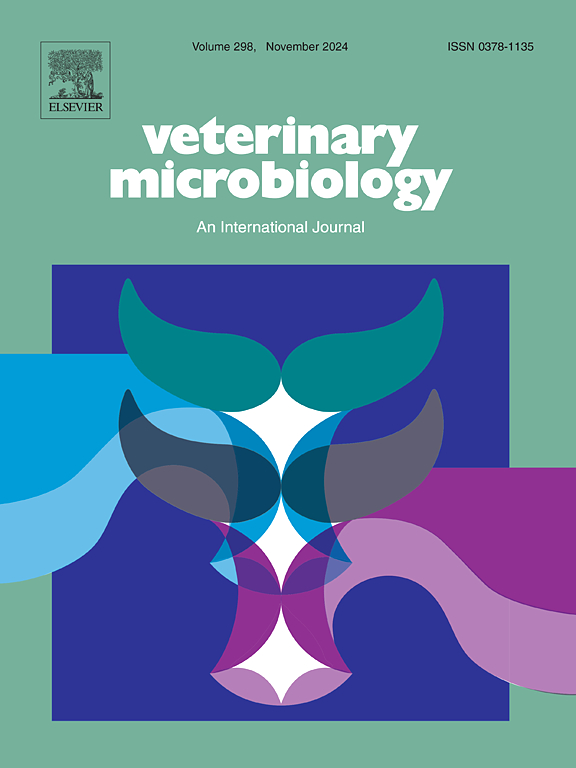Antimicrobial prophylaxis in dogs undergoing catheter-based cardiac interventions and pacemaker implantation – A survey
IF 2.7
2区 农林科学
Q3 MICROBIOLOGY
引用次数: 0
Abstract
Guidelines for prophylactic antimicrobial use for catheter-based cardiac interventions and pacemaker implementation in dogs do not exist. Optimizing antimicrobial use by rationalizing indications and the duration of administration is essential against the ever-growing threat of antimicrobial resistance. The aim of our study was to reveal the current habits of prophylactic antimicrobial use among veterinarians who perform transvascular cardiac interventions in dogs. A digital survey was offered via the mailing list of an international veterinary cardiology-interest group. The 141 respondents reported large variations in protocols (e.g., 47 different prophylaxis protocols for pacemaker implantation). Protocols differed on administration (yes/no), drug, and the route and duration of administration (only intravenous, or intravenous followed by oral antimicrobials). The median duration of antimicrobial course was 7 days (range: 0–21 days). Antimicrobial prophylaxis was administered by 89 % of 141 respondents for occlusion of patent ductus arteriosus, 76 % of 139 respondents for balloon valvuloplasty of pulmonary valve stenosis, 93 % of 56 respondents for transpulmonary stenting, and 96 % of 136 respondents for transvenous pacemaker implantation. The existence of institutional guidelines was reported by 30 % of the respondents, although these also showed substantial variation (e.g., 27 guidelines from 40 institutions for pacemaker implantation). Veterinarians use prophylactic antimicrobials more often and for longer periods for cardiac interventions than their human counterparts. Antibiotic prophylaxis shows little consistency between veterinarians, and does not appear to be supported by evidence of necessity. This warrants re-evaluation of use, and creation of guidelines describing rational use of antimicrobials in interventional cardiac procedures.
接受导管心脏干预和起搏器植入的狗的抗菌预防-一项调查
目前尚不存在犬用导管心脏介入和起搏器预防性抗菌药物使用指南。通过使适应症和给药时间合理化来优化抗菌素使用,对日益增长的抗菌素耐药性威胁至关重要。我们研究的目的是揭示目前在对狗进行经血管心脏干预的兽医中预防性使用抗菌药物的习惯。通过国际兽医心脏病学兴趣小组的邮件列表提供了一项数字调查。141名应答者报告了方案的巨大差异(例如,47种不同的起搏器植入预防方案)。方案在给药(是/否)、药物、给药途径和持续时间(仅静脉注射,或静脉注射后再口服抗菌剂)方面存在差异。抗菌疗程的中位持续时间为7天(范围:0-21 天)。141例动脉导管未闭患者中有89% %使用抗菌素预防治疗,139例球囊瓣膜成形术患者中有76% %使用抗菌素预防治疗,56例经肺支架患者中有93% %使用抗菌素预防治疗,136例经静脉起搏器植入患者中有96% %使用抗菌素预防治疗。30% %的应答者报告了机构指南的存在,尽管这些指南也显示出很大的差异(例如,来自40个起搏器植入机构的27份指南)。与人类相比,兽医使用预防性抗菌剂进行心脏干预的频率更高,时间更长。抗生素预防在兽医之间显示出很少的一致性,并且似乎没有必要的证据支持。这需要重新评估使用情况,并制定指南,描述介入性心脏手术中抗菌药物的合理使用。
本文章由计算机程序翻译,如有差异,请以英文原文为准。
求助全文
约1分钟内获得全文
求助全文
来源期刊

Veterinary microbiology
农林科学-兽医学
CiteScore
5.90
自引率
6.10%
发文量
221
审稿时长
52 days
期刊介绍:
Veterinary Microbiology is concerned with microbial (bacterial, fungal, viral) diseases of domesticated vertebrate animals (livestock, companion animals, fur-bearing animals, game, poultry, fish) that supply food, other useful products or companionship. In addition, Microbial diseases of wild animals living in captivity, or as members of the feral fauna will also be considered if the infections are of interest because of their interrelation with humans (zoonoses) and/or domestic animals. Studies of antimicrobial resistance are also included, provided that the results represent a substantial advance in knowledge. Authors are strongly encouraged to read - prior to submission - the Editorials (''Scope or cope'' and ''Scope or cope II'') published previously in the journal. The Editors reserve the right to suggest submission to another journal for those papers which they feel would be more appropriate for consideration by that journal.
Original research papers of high quality and novelty on aspects of control, host response, molecular biology, pathogenesis, prevention, and treatment of microbial diseases of animals are published. Papers dealing primarily with immunology, epidemiology, molecular biology and antiviral or microbial agents will only be considered if they demonstrate a clear impact on a disease. Papers focusing solely on diagnostic techniques (such as another PCR protocol or ELISA) will not be published - focus should be on a microorganism and not on a particular technique. Papers only reporting microbial sequences, transcriptomics data, or proteomics data will not be considered unless the results represent a substantial advance in knowledge.
Drug trial papers will be considered if they have general application or significance. Papers on the identification of microorganisms will also be considered, but detailed taxonomic studies do not fall within the scope of the journal. Case reports will not be published, unless they have general application or contain novel aspects. Papers of geographically limited interest, which repeat what had been established elsewhere will not be considered. The readership of the journal is global.
 求助内容:
求助内容: 应助结果提醒方式:
应助结果提醒方式:


